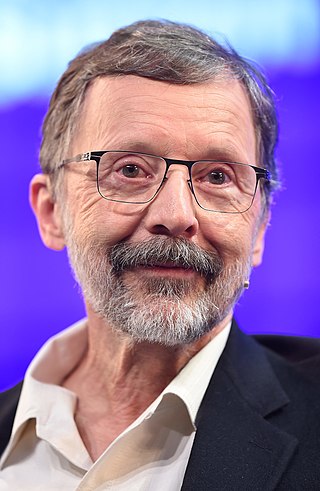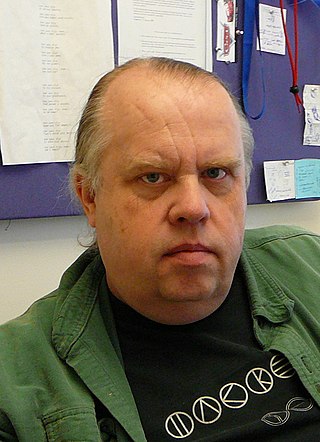Related Research Articles

Autodesk Maya, commonly shortened to just Maya, is a 3D computer graphics application that runs on Windows, macOS and Linux, originally developed by Alias and currently owned and developed by Autodesk. It is used to create assets for interactive 3D applications, animated films, TV series, and visual effects.

Edwin Earl "Ed" Catmull is an American computer scientist who is the co-founder of Pixar and was the President of Walt Disney Animation Studios. He has been honored for his contributions to 3D computer graphics, including the 2019 ACM Turing Award.

John Leroy Hennessy is an American computer scientist, academician and businessman who serves as Chairman of Alphabet Inc. Hennessy is one of the founders of MIPS Computer Systems Inc. as well as Atheros and served as the tenth President of Stanford University. Hennessy announced that he would step down in the summer of 2016. He was succeeded as president by Marc Tessier-Lavigne. Marc Andreessen called him "the godfather of Silicon Valley."

Thomas Douglas Selkirk Duff is a computer programmer.

Garth Alan Gibson is a computer scientist from Carnegie Mellon University. Gibson's developed the RAID taxonomy of redundant data storage systems, along with David A. Patterson and Randy Katz.
Steven Jeromy Carrière is a Canadian computer software engineer.
Pixar RenderMan is proprietary photorealistic 3D rendering software produced by Pixar Animation Studios. Pixar uses RenderMan to render their in-house 3D animated movie productions and it is also available as a commercial product licensed to third parties. In 2015, a free non-commercial version of RenderMan became available.

Loren C. Carpenter is a computer graphics researcher and developer.
Dan Dodge is a cocreator of the QNX microkernel real-time operating system, with Gordon Bell. They began the project while students at the University of Waterloo in 1980. Dodge then moved to Kanata, Ontario, a high-tech area outside Ottawa, to start Quantum Software Systems. It was later renamed QNX Software Systems to avoid confusion with a hard drive manufacturer. The first commercial version of QNX was released for the Intel 8088 central processing unit (CPU) in 1982.

Rob Burgess is a Canadian executive in the technology industry. He was the chief executive officer of Macromedia Inc. from 1996 to 2005 and chairman from 1997 to 2005. Prior to that, he was CEO of Alias Research from 1991 to 1995.

William "Bill" Reeves is a Canadian animator and technical director known for working with John Lasseter on the animated shorts Luxo Jr. and The Adventures of André and Wally B.

James F. O'Brien is a computer graphics researcher and professor of computer science and electrical engineering at the University of California, Berkeley. He is also co-founder and chief science officer at Avametric, a company developing software for virtual clothing try on. In 2015, he received an award for Scientific and Technical Achievement from the Academy of Motion Pictures Arts and Sciences.
James George Mitchell is a Canadian computer scientist. He has worked on programming language design and implementation, interactive programming systems, dynamic interpreting and compiling, document preparing systems, user interface design, distributed transactional file systems, and distributed, object-oriented operating systems. He has also worked on the design of hardware for computer graphics, high-level programming language execution, and audio input/output.
The J.W. Graham Medal in Computing and Innovation is an award given annually by the University of Waterloo and the University of Waterloo Faculty of Mathematics to "recognize the leadership and many innovative contributions made to the University of Waterloo, and to the Canadian computer industry." Recipients of this award receive a gold medal and certificate. Recipients are graduates of the University of Waterloo Faculty of Mathematics from business, education, or government.

James Wesley Graham, OC was a Canadian professor of computer science at the University of Waterloo.
Dan Lemmon is a New Zealand visual effects supervisor. In 2012, he was nominated for an Academy Award for the movie Rise of the Planet of the Apes. This was in the category of Academy Award for Best Visual Effects, his nomination was shared with Daniel Barrett, Joe Letteri and R. Christopher White.
Dave Boswell is a Canadian computer scientist who was awarded the J.W. Graham Medal for his contributions to the field in 2003.
Terry Stepien is a Canadian computer scientist, and protege of Wes Graham, an influential professor of Computer Science at Stepien's alma mater, the University of Waterloo. Stepien earned a Bachelor of Mathematics in 1981, and his Masters in 1988.
Rahul Chandrakant Thakkar is an Indian-American software inventor who was one of the 33 recipients of Academy Award for scientific and technical achievement in 2016. Thakkar won the Academy Award for creating the "groundbreaking design" of DreamWorks Animation Media Review System, a scalable digital film review platform.
Eric Veach is a Canadian computer scientist who won two technical Academy Awards.
References
- 1 2 3 "Kim Davidson: President and Chief Operating Officer, Side Effects Software Inc". University of Waterloo . Retrieved 2015-09-25.
- ↑ "Kim Davidson". People behind the Pixels . Retrieved 2015-09-25.
- ↑ Peter Vamos (1999-08-09). "Davidson animated about new project". Playback magazine . Retrieved 2015-09-25.
- ↑ "Recipients of the J.W. Graham Medal in Computing & Innovation". University of Waterloo . Retrieved 2015-09-25.